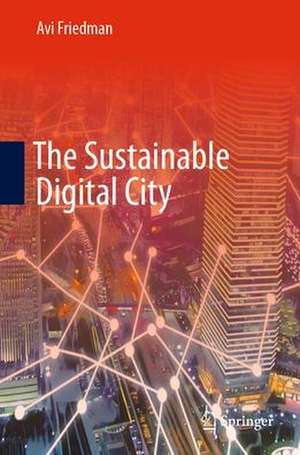The Sustainable Digital City
Autor Avi Friedmanen Limba Engleză Hardback – 6 apr 2023
Preț: 681.74 lei
Preț vechi: 885.38 lei
-23% Nou
Puncte Express: 1023
Preț estimativ în valută:
130.46€ • 135.44$ • 108.79£
130.46€ • 135.44$ • 108.79£
Carte tipărită la comandă
Livrare economică 18-24 martie
Preluare comenzi: 021 569.72.76
Specificații
ISBN-13: 9783031254871
ISBN-10: 3031254872
Pagini: 196
Ilustrații: XIV, 196 p. 88 illus., 74 illus. in color.
Dimensiuni: 155 x 235 mm
Greutate: 0.52 kg
Ediția:2023
Editura: Springer International Publishing
Colecția Springer
Locul publicării:Cham, Switzerland
ISBN-10: 3031254872
Pagini: 196
Ilustrații: XIV, 196 p. 88 illus., 74 illus. in color.
Dimensiuni: 155 x 235 mm
Greutate: 0.52 kg
Ediția:2023
Editura: Springer International Publishing
Colecția Springer
Locul publicării:Cham, Switzerland
Cuprins
1. The Digital Revolution and Urbanity.- 2. A Need for Sustainable Urban Environments .- 3. Efficient, Safe and Comfortable Mobility .- 4. Work and the City .- 5. Efficient Energy Distribution and Waste Management .- 6. Knowledge Transfer, Social Engagement and Culture.- 7. Well Being, Public Engagement, and Health Care .- 8. Home Automation .- 9. Digital Contribution to Urban Planning and Architecture .- 10. Digital Economy and Place Making.- 11. Future Digital Cities.
Notă biografică
Dr. Avi Friedman is Professor of Architecture, McGill University, Montreal, Canada and Principal, at Avi Friedman Consultants, Inc.
Textul de pe ultima copertă
This book explores the rise of technology-centered urban planning and the diffusion of these practices around the world. Seven axes of urban planning have been selected to highlight how data and technology currently work and how these systems can be improved going forward. Each aspect is explored in its own chapter that combines narrative description, illustrations, and case studies to show how technology currently shapes our cities and how this may impact the urban environments. Topics include infrastructure, mobility, energy use and distribution, work, public health, and knowledge transfer among others. The book also demonstrates how these aspects are tied to and affect the four pillars of sustainability: environment, society, economy, and culture.
- Demonstrates current practices and explores specific ways of how technology and data can influence urban planning and city life in the future
- Combines academic research and case studies
- Draws a link between these ideas and practices to illustrate how they can make cities more sustainable
Caracteristici
Demonstrates current practices and explores specific ways of how technology and data can influence urban Combines academic research and case studies Draws a link between these ideas and practices to illustrate how they can make cities more sustainable
